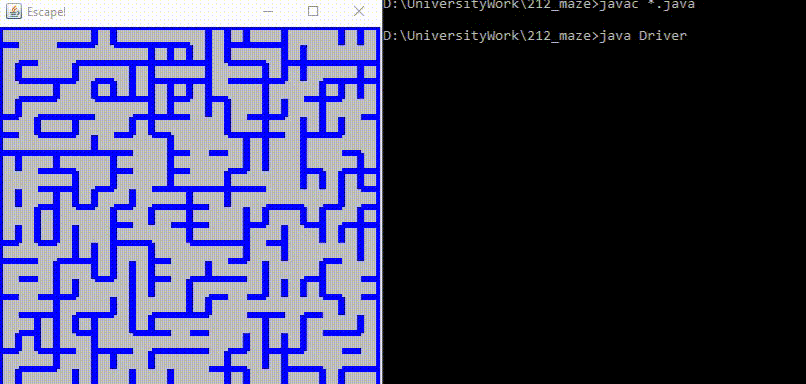Project Overview:
I developed a Java Maze Solving Algorithm displayed visually in Swing. For this project I was provided with how to generate mazes through Lancaster University and then I was tasked with creating an depth-first search algorithm to find the shortest path from a starting point to an exit, highlighting the solution and letting the user continually select different routes.
How the maze solving program works
Program Structure
This program is built using Swing and generates a 20x20 grid of buttons, each containing a random number of walls (around 500 by default). You can increase the number of walls by adding an optional argument java Driver <number>, where number specifies the additional walls you want to add.
Usage
Setting Start and End Points for initial path: You can choose the starting point by left-clicking on a tile and set the exit point by right-clicking. Once both starting and ending points are set, the shortest path will be generated. The path will be highlighted, and its length will be displayed in the console.
Creating a New Path: To find a new path, simply set the start and end points again, and the previous highlighted path will be removed.
The Recursive Algorithm
Algorithm Overview
The algorithm employed is a depth-first pathing algorithm with elements inspired by Dijkstra’s algorithm, where it stores the previous quickest way to reach a node. It begins as a depth-first search from the starting point, checking each possible direction (up and right) until it cannot proceed further. If it reaches a dead end, it backtracks to the previous call made on the previous tile.
Optimizing Performance
Each time a tile is reached, the program stores the length taken to reach that tile. When attempting to move in a direction, it checks if the current path length is shorter than the tile’s smallest path, significantly enhancing performance. This logic also prevents the algorithm from getting stuck in loops.
Handling Unsolvable Mazes
If no path is possible, the program will print to the console that it is impossible to create a path.
Visual Demonstration
Below is a visual demonstration of the maze-solving program in action:
Closing Thoughts:
Developing the Maze Solving Algorithm was an engaging and rewarding project completed during my second year at university, under a tight one-week deadline. It provided an opportunity to apply my Java programming skills to create a practical tool for solving mazes.
While this algorithm effectively finds the shortest path, I later expanded my pathfinding knowledge with the development of the A* pathing algorithm for the Campus Crawling Game, which you can explore here.

Comments powered by Disqus.